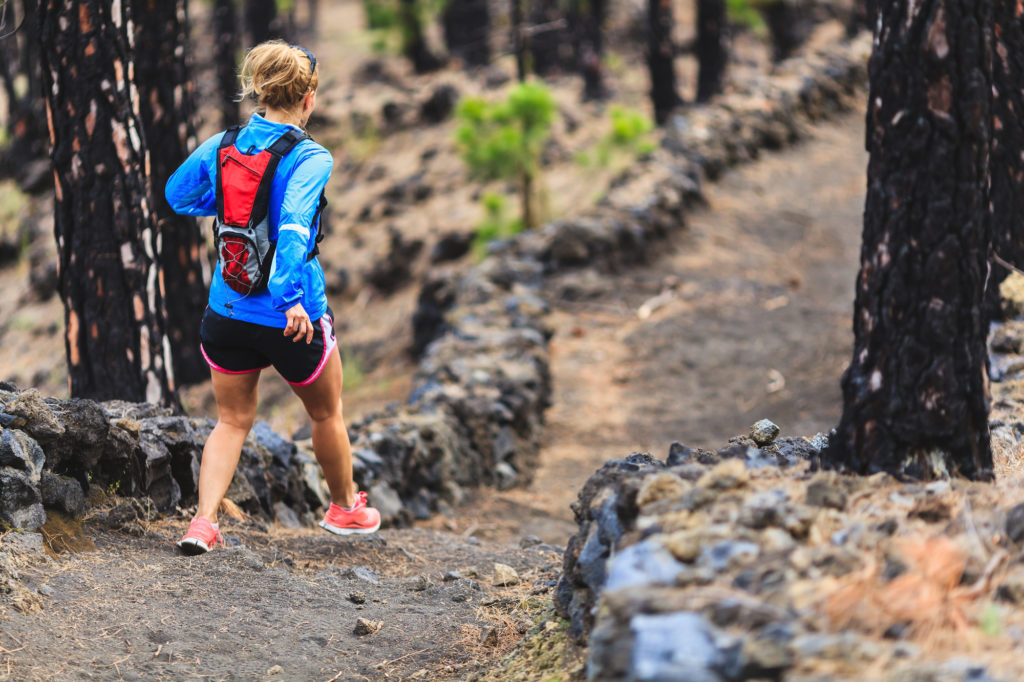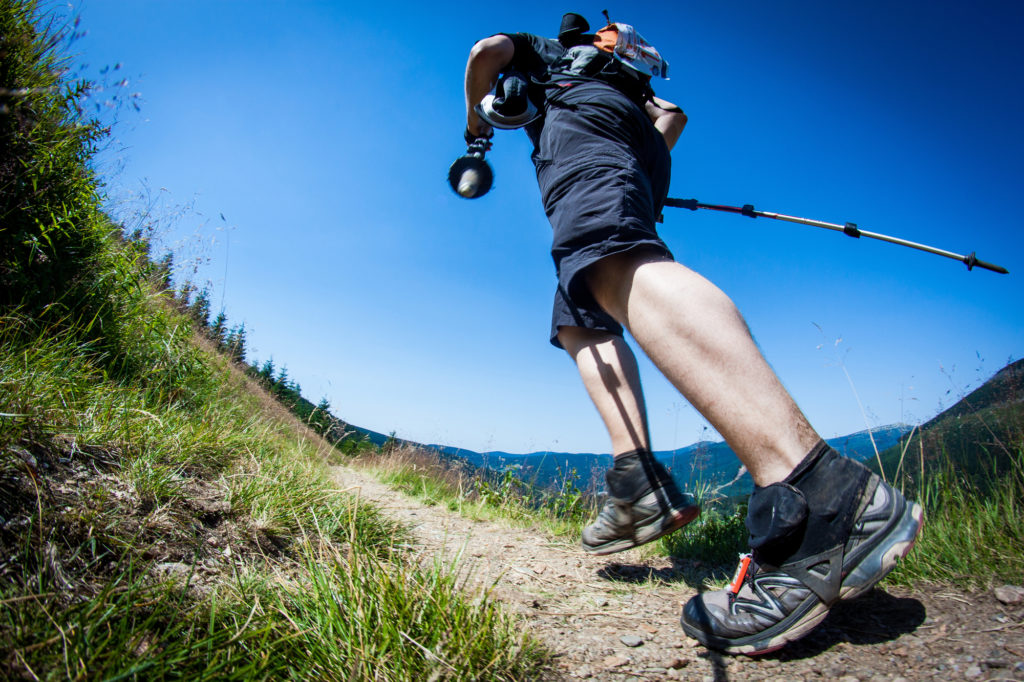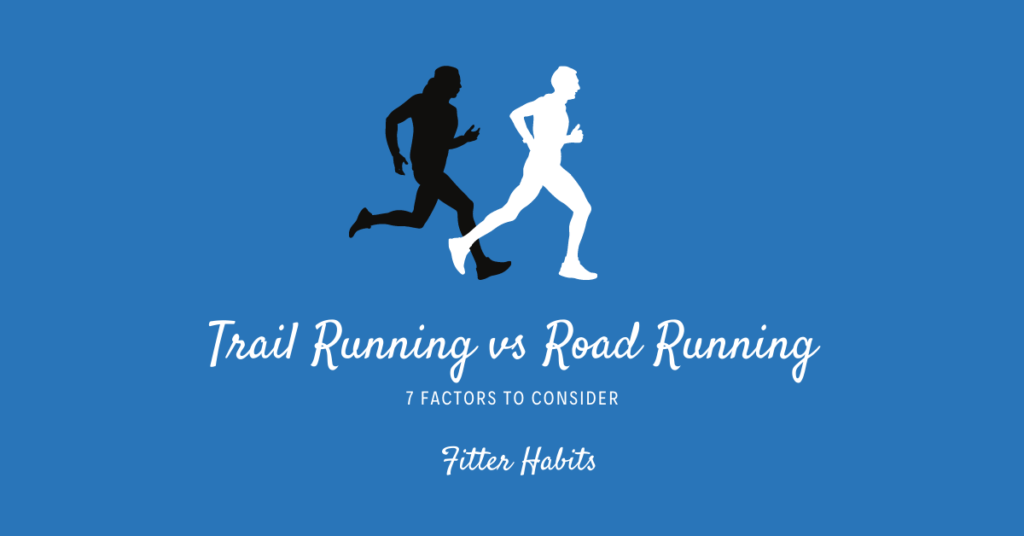Trail running vs road running. Both have their place in any runner’s training plan.
The thought of hitting the woods for your morning run has probably crossed your mind before. Or maybe you’re already an avid trail runner and can’t imagine hitting the concrete every day.
Either way, trail running is the perfect way to combine your favorite aerobic exercise with the great outdoors. Not to mention trail running has many great health benefits, like less impact on your joints.
In this article, we’ll cover the differences between trail running and road running and some factors to consider before your next run.
Contents
What is Road Running?
Road runners run on a road, gravel, asphalt or a path of some sort. They typically run through a town or a suburb. They also run on a measured course if racing. Marathons and other popular races often take place on the road.
What is Trail Running?

Trail running involves uneven terrain in the woods combined with hills, mountains, or other steep inclines. Sometimes, trail running can blend with ultrarunning, covering distances greater than 26.2 miles (the standard marathon length). Other trail runs are shorter in distance.
Pace and speed per mile are often the focus for road runners. Trail runners are more concerned with a route and time spent on the trails.
You might also find our GPS watch accuracy guide useful.
1. Nature
Trail running involves spending more time in nature, whether in a park, nearby mountain or a remote region. That’s relaxing and has a meditative quality. It’s also a good way to explore a place on holidays or while traveling.
Road running, on the other hand, involves running in built-up areas. That’s great for training, but less ideal if you like time in nature.
2. Speed Work
Road running lends itself to speed work as you can pick an even route in terms of elevation or distance and run it repeatedly.
The uneven terrain of trails means it’s more difficult for speed work and intervals. Some trail runners walk parts of challenging courses due to downed trees, rocks and other obstacles.
3. Time
Unless you live near a park, trail runs take longer. I have to drive half an hour to a popular nearby scenic trail. That’s not too far, but factor in travel time into a longer run.
Plus, completing the trail run takes longer than a route of similar distance on the roads.
On the other hand, a road runner can usually put on a pair of trainers and leave their house or office and be back in time for lunch. Most road runners can also complete challenging sessions close to where they live or work.
4. Traffic
Trail runners don’t have to deal with traffic once they get going. It’s fun to get away from loud cars and the city.
Road runners, on the other hand, must be mindful of traffic. They’re also probably running near other people, cyclists and walkers.
5. Hills
A lot of trails involves running uphill… and downhill.
If you’re new to trail running, expect some muscle soreness if the route has lots of hills. Going downhill is challenging, as you use different muscle groups and exert more effort to focus on maintaining control.
On more difficult descents, think small, quick steps. On easier or smoother downhills, long striders can help you cruise down faster. Either way, keep your eyes a few paces ahead of your feet to watch out for hazards, as stopping or making sudden changes will be more challenging.
6. Gear

If you plan n trail running regularly, it’s best to invest in some appropriate gear.
If you’re running in low light settings, wear a headlamp, and keep a map of aid stations to ensure your safety.
The transition from the road to the trail is more comfortable with the right gear. Road running shoes are lightweight and designed for speed.
It would help if you had sturdier shoes with grips and traction for rough terrains like roots, sand, and rocks for trails.
Check out your local running store, as they’ll be familiar with trails in the area and will know which type of trail-running shoe is best suited to your needs.
If you’re committed to the sport, invest in poles for uphills. According to the National Library of Medicine National Center for Biotechnology Information, they don’t save energy. However, a lower perceived rate of exertion and can help with steeper climbs.
You may also want to invest in a hydration running vest, particularly if you’re going to become an ultrarunner.
7. Strength
Strength training is crucial for off-road runs. When on the trails, you use different muscle groups to help you control sudden speed changes, stabilize on unsteady ground, avoid tree roots, and push off rocks.
Consider a routine that emphasizes core strength and hip strength, and you’ll soon see improvement in your stability and mobility. Your running coach will thank you, and covering those uneven surfaces will quickly become more manageable.
8. Routes
Getting the most from a trail run means taking extra time to plan a route in terms of elevation, distance and profile. That’s more involved than a standard road run around the block.
To find local trails near you, check out.
- Active: Great for finding trail races (if you’re ready for a break from road races)
- AllTrails: Check out user reviews and pictures of trails, or download maps for offline use
- Trail Run Project: You’ll discover over 225,000 miles of trails
- RootsRated: Local guides provide info about local trails
- TrailLink: Use this site to search for trails by terrain (like grass or dirt)
9. The Weather
Road runners and trail runners both contend with challenging weather conditions like humidity, heat, rain and wind. However, weather is harder on trail runners, particularly over long-distance. Trail runners plan ahead by bringing a change of clothes, suncream, rain gear, a headlamp and other equipment.
I ran and walked up a 500-metre trail a while back, and the cold and wind on top of that hill were more bracing than a typical road run session.
What to Expect When as a New Trail Runner
If you’re transitioning from road races to the backcountry, prepare to feel out of shape. Your heart rate will be higher or experience more fluctuations, and you’ll likely feel sore in new places and maybe even have a few bruises.
There’s nothing wrong with taking things slow. Combine new altitudes, heat, rocky terrains, and steep grades, and it may be more efficient to power hike up hills than run.
You’ll reach the top nearly as fast, but your heart rate stays lower, and you use different muscle groups (which can turn the incline into a much-needed rest).
Tips on Form for Trail Running
Whether you’re running on a softer surface or technical trail, focus on a short stride and a slower speed, both of which lower risk of injury. This combination also enables quicker reaction times and better ankle mobility, over rocks and uneven routes.
Running isn’t all about your legs. Your arms can help you maintain your stride, provide additional balance over complex terrain, or help you power up that incline.
Remember to engage your core for better control over your speed and faster reaction times to terrain or incline changes.
The Final Word: Trail Running vs Road Running
There’s no right or wrong type of running. Each discipline has its hard-core fans, and for a good reason. We think doing a combination of half-marathons on the road and cross country runs through the forest will help stave off boredom and keep you super fit.
You can combine the hard training of road running with the excitement and tranquility of training outdoors in scenic locations. Perhaps, run on the road during the week and hit the trails at the weekend when you’ve more free time.
Whichever preferred style of running, the right equipment and an enthusiastic mindset will help you get more from your next run.



